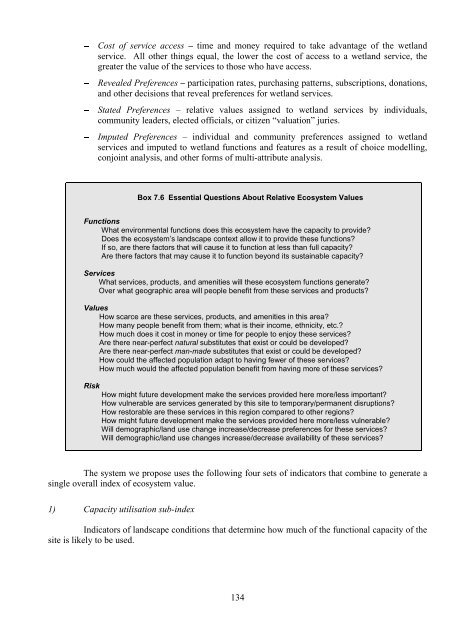Valuation of Biodiversity Benefits (OECD)
Valuation of Biodiversity Benefits (OECD)
Valuation of Biodiversity Benefits (OECD)
- No tags were found...
Create successful ePaper yourself
Turn your PDF publications into a flip-book with our unique Google optimized e-Paper software.
- Cost <strong>of</strong> service access – time and money required to take advantage <strong>of</strong> the wetlandservice. All other things equal, the lower the cost <strong>of</strong> access to a wetland service, thegreater the value <strong>of</strong> the services to those who have access.- Revealed Preferences – participation rates, purchasing patterns, subscriptions, donations,and other decisions that reveal preferences for wetland services.- Stated Preferences – relative values assigned to wetland services by individuals,community leaders, elected <strong>of</strong>ficials, or citizen “valuation” juries.- Imputed Preferences – individual and community preferences assigned to wetlandservices and imputed to wetland functions and features as a result <strong>of</strong> choice modelling,conjoint analysis, and other forms <strong>of</strong> multi-attribute analysis.Box 7.6 Essential Questions About Relative Ecosystem ValuesFunctionsWhat environmental functions does this ecosystem have the capacity to provide?Does the ecosystem’s landscape context allow it to provide these functions?If so, are there factors that will cause it to function at less than full capacity?Are there factors that may cause it to function beyond its sustainable capacity?ServicesWhat services, products, and amenities will these ecosystem functions generate?Over what geographic area will people benefit from these services and products?ValuesHow scarce are these services, products, and amenities in this area?How many people benefit from them; what is their income, ethnicity, etc.?How much does it cost in money or time for people to enjoy these services?Are there near-perfect natural substitutes that exist or could be developed?Are there near-perfect man-made substitutes that exist or could be developed?How could the affected population adapt to having fewer <strong>of</strong> these services?How much would the affected population benefit from having more <strong>of</strong> these services?RiskHow might future development make the services provided here more/less important?How vulnerable are services generated by this site to temporary/permanent disruptions?How restorable are these services in this region compared to other regions?How might future development make the services provided here more/less vulnerable?Will demographic/land use change increase/decrease preferences for these services?Will demographic/land use changes increase/decrease availability <strong>of</strong> these services?The system we propose uses the following four sets <strong>of</strong> indicators that combine to generate asingle overall index <strong>of</strong> ecosystem value.1) Capacity utilisation sub-indexIndicators <strong>of</strong> landscape conditions that determine how much <strong>of</strong> the functional capacity <strong>of</strong> thesite is likely to be used.134












